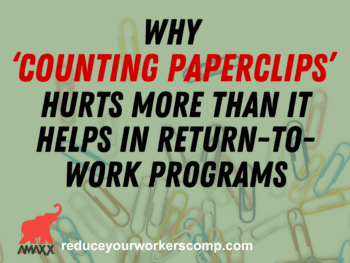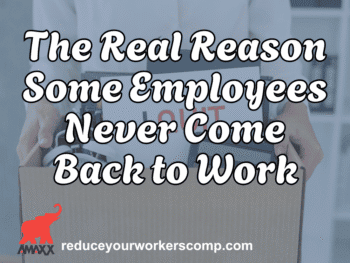
This post is one in a 3-part series:
A follow-training on How to Coordinate Return to Work with ADA Compliance initiated additional questions:
- ADA – If light duty cannot be accommodated, should FMLA run concurrently?
- ADA – Do All Work Comp Injuries Fall Under the Americans with Disabilities Act Amendments Act (ADAAA)?
- ADA – Is it against the law not to hire a person with a disability for a physical position?
In Workers Compensation, many injured workers do not feel as if they can return to work on light duty. How does this dialogue happen when they are opposed to Return To Work?
If the employee has accrued annual or sick leave, then he or she has the right to use it just like any other employee. And if the employee is entitled to FMLA leave, then the employer would need to provide it.
Click Link to Access Free PDF Download
“13 Research Studies to Prove Value of Return-to-Work Program & Gain Stakeholder Buy-In”
If the employee has no leave available, and everyone agrees that the return-to-work assignment is consistent with his or her medical needs, then the employer can require the individual to return. It would be just like requiring someone who hasn’t been injured to come to work, even if he or she would prefer to stay home.
However, you are describing a situation in which the employee doesn’t agree that the return-to-work assignment is consistent with his or her medical needs. If the medical documentation you have so far doesn’t address the issue, or if the employee disagrees with the medical doctor, then the employer can require the employee to provide documentation in support of his or her position, or request an independent exam. The employee has a duty to participate in the interactive process as well.
Eventually, the employer will have to make a decision as to whether the person can do the proposed assignment. If the employee can, in fact, do the assignment, then the employer can require the employee to return to work.
[Publishers Note: The best way to ensure compliance with a return to work program is to communicate your policy before an injury occurs, then reinforce the process at the time of injury. Most employees have not had a previous workers compensation injury, so they don’t know what to expect. A simple employee brochure outlining your policy, the employers’ role, and the employees’ role is an effective tool.]What if the employee doesn’t want to return-to-work, but wants to be out of work?
Of course, if the employee has accrued annual or sick leave, then he or she has the right to use it just like other employees. And if the employee is entitled to FMLA leave, then the employer would need to provide the required leave. But if the employee has no leave available, and if everyone agrees that the return-to-work assignment is consistent with the employee’s medical needs, then the employer can require the individual to return. It would be just like requiring someone who hasn’t been injured to come to work, even if he or she would prefer to stay home.
FREE DOWNLOAD: “13 Research Studies to Prove Value of Return-to-Work Program & Gain Stakeholder Buy-In”
Author:

Dr. Konopasky joined EEOC after receiving his J.D. from Stanford Law School. Prior to law school, he received his Ph.D. in philosophy from Princeton University and served as an adjunct professor of philosophy at Rutgers University, Tulane University, and the University of New Orleans.
Author:

To Learn Step-By-Step instructions to create your Return to Work program, Purchase Your Ultimate Guide To Mastering Workers Comp Costs.















